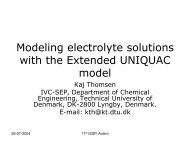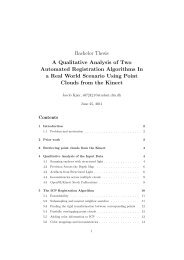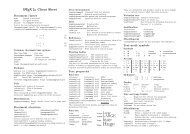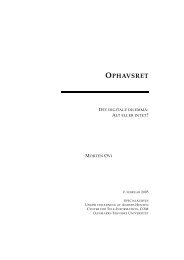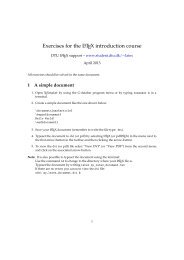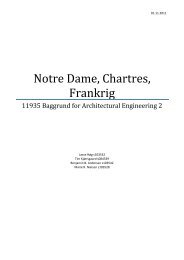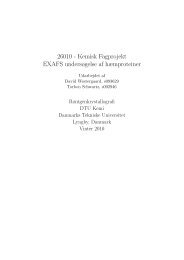Thermodynamic modeling of some properties of electrolyte solutions
Thermodynamic modeling of some properties of electrolyte solutions
Thermodynamic modeling of some properties of electrolyte solutions
You also want an ePaper? Increase the reach of your titles
YUMPU automatically turns print PDFs into web optimized ePapers that Google loves.
<strong>Thermodynamic</strong> <strong>modeling</strong> <strong>of</strong><br />
<strong>some</strong> <strong>properties</strong> <strong>of</strong> <strong>electrolyte</strong><br />
<strong>solutions</strong><br />
Kaj Thomsen<br />
IVC-SEP, Department <strong>of</strong> Chemical<br />
Engineering, Technical University <strong>of</strong><br />
Denmark, DK-2800 Lyngby, Denmark.<br />
E-mail: kth@kt.dtu.dk<br />
1
Models for <strong>electrolyte</strong>s<br />
• Long range interactions<br />
– Debye-Hückel electrostatic term<br />
• Short range interactions<br />
– Pitzer virial expansion in molality<br />
– Electrolyte NRTL<br />
– UNIQUAC<br />
• Gas phase fugacity<br />
– PR or SRK equation <strong>of</strong> state<br />
3
Extended UNIQUAC<br />
• Excess gibbs energy function<br />
– Debye-Hückel term<br />
– UNIQUAC term<br />
• Activity coefficients and thermal<br />
<strong>properties</strong> are derived by standard<br />
methods known from classical<br />
thermodynamics<br />
4
Standard states<br />
• Water is the solvent<br />
RT ln( x ); 1<br />
0<br />
w w w w w<br />
<br />
<br />
x w<br />
1<br />
• Ions, non-<strong>electrolyte</strong>s and gases are<br />
treated equally as solutes in water<br />
<br />
* * *<br />
RT ln( x ); 1<br />
i i i i i<br />
xi<br />
0<br />
i<br />
5
Gibbs energy <strong>of</strong> transfer<br />
Kamps, A.P-S., Ind. & Eng. Chem. Res., 44(2005)201-225<br />
6
90<br />
Relative permittivity<br />
Relative permittivity <strong>of</strong> aqueous <strong>solutions</strong><br />
Relative permittivity .<br />
80<br />
70<br />
60<br />
50<br />
40<br />
30<br />
20<br />
NaCl, Hasted et al, 1948<br />
Ethanol, Åkerlöf, 1932<br />
10<br />
0<br />
0 10 20 30 40 50 60 70 80 90 100<br />
Mass % solute<br />
7
Conventional and ”Mixed solvent”<br />
approach<br />
RT ln x RT ln <br />
* *<br />
i i i i<br />
ideal<br />
excess<br />
"Mixed solvent" approach:<br />
<br />
Mixed solvent<br />
RT ln x RT ln <br />
Mixed solvent<br />
i i i i<br />
ideal<br />
excess<br />
In the ”Mixed solvent” approach, the standard state chemical<br />
potential is a function <strong>of</strong> the solvent composition<br />
8
Model parameters<br />
• Standard UNIQUAC parameters<br />
– Volume parameter for each species<br />
– Surface area parameter for each species<br />
– Interaction energy parameter for each<br />
pair <strong>of</strong> species<br />
• Temperature dependence <strong>of</strong> interaction<br />
energy parameter<br />
• Number <strong>of</strong> parameters:<br />
• eUNIQUAC ~ eNRTL
Databank<br />
• Over 100,000 experimental data on<br />
electronic form<br />
– Activity/osmotic coefficient<br />
– Enthalpy <strong>of</strong> mixing<br />
– Heat capacity<br />
– Degree <strong>of</strong> dissociation<br />
– Gas solubility<br />
– Density<br />
– Salt solubility (Solid-liquid equilibrium)<br />
– Liquid-liquid equilibrium<br />
– Vapor-liquid equilibrium<br />
10
Parameter estimation<br />
• Critical review <strong>of</strong> data<br />
• Non-linear least squares optimization<br />
– Differences between experimental and<br />
calculated values are minimized<br />
– The calculation <strong>of</strong> the difference<br />
depends on the type <strong>of</strong> data<br />
– All data <strong>of</strong> same type weighted equally<br />
11
Anchoring <strong>of</strong> parameters<br />
• No binary solution <strong>of</strong> one ion in<br />
water<br />
• Parameters <strong>of</strong> ions are relative to<br />
each other<br />
• The hydrogen ion is used as anchor<br />
– Parameters for the hydrogen ion are<br />
given fixed values<br />
12
Thermal <strong>properties</strong><br />
• Excess enthalpy is calculated from the<br />
temperature derivatives <strong>of</strong> activity<br />
coefficients.<br />
• By using thermal <strong>properties</strong> in the<br />
parameter estimation a better<br />
temperature dependency <strong>of</strong> activity<br />
coefficients is achieved<br />
• Clear distinction between temperature<br />
dependency and concentration<br />
dependency<br />
13
Parameters<br />
• H + , Na + , K + , NH 4+<br />
, Ca 2+ , Mg 2+ , Mn 2+ , Fe 2+ ,<br />
Co 2+ , Ni 2+ , Cu 2+ , Zn 2+ , Ba 2+ , Sr 2+<br />
• F - , Cl - , Br - , NO 3-<br />
, SO 4<br />
2-<br />
, HSO 4-<br />
, OH - , CO 3<br />
2-<br />
,<br />
HCO 3-<br />
, S 2<br />
O 8<br />
2-<br />
, SO 3<br />
2-<br />
, HSO 3- , HPO 4- , H 2 PO 4<br />
-<br />
• H 2 O, CO 2 , NH 3 , SO 2 , HNO 3 , H 3 PO 4 ,<br />
C 12 H 22 O 11 , CH 3 OH, C 2 H 5 OH, n-C 3 H 7 OH, i-<br />
C 3 H 7 OH, n-C 4 H 9 OH, i-C 4 H 9 OH, s-C 4 H 9 OH,<br />
t-C 4 H 9 OH<br />
14
Equilibrium calculations<br />
• Speciation equilibrium<br />
• +<br />
• Solid-liquid equilibrium<br />
• Vapor-liquid equilibrium<br />
• Liquid-liquid equilibrium<br />
15
Speciation equilibria<br />
NH 3 (aq)+H 2 O NH 4+ (aq)+OH - (aq)<br />
Equilibrium condition:<br />
<br />
NH H O NH OH<br />
<br />
3 2 4<br />
- -<br />
a a<br />
- ln<br />
RT a a<br />
* * * 0 * *<br />
NH OH NH H O NH OH<br />
<br />
- -<br />
4 3 2<br />
4<br />
*<br />
NH<br />
H O<br />
3 2<br />
-<br />
16
Solid-liquid equilibrium<br />
• At equilibrium, the chemical potential<br />
<strong>of</strong> the pure crystalline salt(hydrate)<br />
equals the sum <strong>of</strong> the chemical<br />
potentials <strong>of</strong> the salts components in<br />
solution<br />
• It is required that other salts are not<br />
supersaturated.<br />
17
Vapor-liquid equilibrium<br />
• Equality <strong>of</strong> chemical potential in gas<br />
phase and in liquid phase (Gamma-phi<br />
method)<br />
• Gas phase fugacities are calculated<br />
with the Soave-Redlich-Kwong<br />
equation <strong>of</strong> state<br />
<br />
CO ( g ) CO ( aq)<br />
2 2<br />
P <br />
RT ln y ˆ RT ln x<br />
<br />
<br />
0, ig<br />
* *<br />
CO CO CO CO CO CO<br />
P0<br />
2 2 2 2 2 2<br />
<br />
18
Liquid-liquid equilibrium<br />
• Equilibrium between component i in<br />
phase I and phase II<br />
I<br />
<br />
i<br />
<br />
RT ln( x ) RT ln( x )<br />
* * I * * II<br />
i i i i i i<br />
• Here the activity product <strong>of</strong> salts rather<br />
than the activities <strong>of</strong> the individual ions<br />
ions are compared<br />
<br />
II<br />
i<br />
( x<br />
) ( x<br />
)<br />
* I * II<br />
i i i i<br />
19
Standard state <strong>properties</strong><br />
• The numerical values <strong>of</strong> standard state<br />
chemical potentials are needed before<br />
equilibrium calculations can be made<br />
• Such values for most solutes and many<br />
salts have been published by NIST<br />
• Those not found are fitted to experimental<br />
data<br />
• Temperature dependence calculated with<br />
classical thermodynamic method<br />
20
90<br />
80<br />
70<br />
Extended UNIQUAC model<br />
Experimental data<br />
--<br />
60<br />
Temperature °C<br />
50<br />
40<br />
30<br />
20<br />
10<br />
0<br />
-10<br />
Ice<br />
Mn(NO 3 ) 2·6H 2 O<br />
Mn(NO 3 ) 2·4H 2 O<br />
Mn(NO 3 ) 2·2H 2 O<br />
Mn(NO 3 ) 2·H 2 O<br />
-20<br />
0 10 20 30 40 50 60 70 80 90 100<br />
Mass percent Mn(NO 3 ) 2<br />
21
120<br />
100<br />
Ca(OH) 2<br />
Temperature °C<br />
80<br />
60<br />
40<br />
20<br />
Calculated<br />
Experimental<br />
0<br />
0 0.05 0.1 0.15 0.2<br />
Mass percent Ca(OH) 2<br />
22
K2CO3 salt fraction<br />
Na2CO3<br />
1<br />
0.9<br />
0.8<br />
0.7<br />
0.6<br />
0.5<br />
0.4<br />
0.3<br />
0.2<br />
0.1<br />
0<br />
Ice<br />
Na 2 CO 3·10H 2 O<br />
NaKCO 3·6H 2 O<br />
Na 2 CO 3·7H 2 O<br />
K 2 CO 3·½H 2 O<br />
Extended UNIQUAC model<br />
Experimental data<br />
Na 2 CO 3·H 2 O<br />
Na 2 CO 3·K 2 CO 3<br />
Na 2 CO 3<br />
-40 -30 -20 -10 0 10 20 30 40 50 60 70 80 90 100 110<br />
Temperature, °C<br />
23
100<br />
90<br />
80<br />
70<br />
60<br />
50<br />
40<br />
30<br />
80<br />
Na 2 CO 3 ∙H 2 O<br />
20<br />
90<br />
Na 2 CO 3<br />
100<br />
10<br />
0<br />
T= 75.0°C<br />
70<br />
60<br />
50<br />
40<br />
30<br />
20<br />
10<br />
0<br />
Na 2 CO 3 ∙K 2 CO 3<br />
100<br />
H 2 O(l)<br />
24<br />
90<br />
80<br />
70<br />
60<br />
Experimental<br />
data, various<br />
sources<br />
Extended<br />
UNIQUAC,<br />
Equilibrium lines<br />
and tie lines<br />
50<br />
40<br />
30<br />
20<br />
K 2 CO 3 ∙½H 2 O<br />
10<br />
0 10 20 30 40 50 60 70 80 90 100<br />
K 2 CO 3<br />
0
90<br />
80<br />
Extended UNIQUAC model<br />
Experimental data<br />
__<br />
5.9 molal NH 3<br />
80°C<br />
CO2 partial pressure, bar<br />
70<br />
60<br />
50<br />
40<br />
30<br />
0.6 m<br />
1 m<br />
6.8 molal NH 3<br />
2 molal 4.1 m<br />
NH 3<br />
9 molal NH 3<br />
12 molal NH 3<br />
20<br />
10<br />
0<br />
0 2 4 6 8 10<br />
CO 2 mol kg -1<br />
25
90<br />
100<br />
10<br />
0<br />
100<br />
90<br />
H 2 O<br />
15°C<br />
20<br />
80<br />
80<br />
70<br />
25°C<br />
30<br />
70<br />
50°C<br />
40<br />
60<br />
60<br />
50<br />
40<br />
75°C<br />
60<br />
50<br />
50<br />
40<br />
70<br />
30<br />
30<br />
80<br />
Thompson and Vener (1948)<br />
20<br />
Armstrong and Eyre (1910)<br />
90<br />
Gerardin (1865)<br />
Schiff (1861)<br />
10<br />
KNO 3<br />
Extended UNIQUAC model<br />
100<br />
Series2<br />
0<br />
Series3<br />
0 10 20 30 Series4 40 50 60 70 80 90 100<br />
26<br />
C 2 H 5 OH<br />
20<br />
10<br />
0
100.00<br />
90.00<br />
80.00<br />
70.00<br />
60.00<br />
50.00<br />
40.00<br />
30.00<br />
20.00<br />
K 2 CO 3<br />
100<br />
10.00<br />
0.00<br />
Iino et al. (1971)<br />
Do & Park (1974)<br />
Extended UNIQUAC<br />
Series2<br />
Series3<br />
30 °C Series4<br />
Series7<br />
20<br />
90<br />
80<br />
70<br />
60<br />
50<br />
40<br />
30<br />
10<br />
0<br />
100<br />
H 2 O<br />
0 10 20 30 40 50 60 70 80 90 100<br />
27<br />
iso-propanol<br />
90<br />
80<br />
70<br />
60<br />
50<br />
40<br />
30<br />
20<br />
10<br />
0
xy - diagram for iso-propanol - water, 1 bar<br />
1<br />
0.9<br />
0.8<br />
y iso-propanol<br />
0.7<br />
0.6<br />
0.5<br />
0.4<br />
0.3<br />
0.2<br />
0.1<br />
0<br />
Extended UNIQUAC model<br />
Marzal et al. (1996)<br />
Saturation with K2CO3<br />
0 0.1 0.2 0.3 0.4 0.5 0.6 0.7 0.8 0.9 1<br />
x iso-propanol<br />
28
4000<br />
J mol -1<br />
3000<br />
2000<br />
1000<br />
Integral heat <strong>of</strong> dilution to infinite dilution<br />
Ext. UNIQUAC<br />
Experimental, 12.5°C<br />
Experimental, 25°C<br />
Experimental, 40°C<br />
Experimental, 60°C<br />
Experimental, 80°C<br />
0<br />
-1000<br />
-2000<br />
-3000<br />
0 2 4 6<br />
Molality <strong>of</strong> KCl<br />
29
50<br />
J mol -1 K -1<br />
Apparent molal heat capacity<br />
0<br />
-50<br />
-100<br />
-150<br />
-200<br />
Ext. UNIQUAC<br />
Experimental, 10°C<br />
Experimental, 25°C<br />
Experimental, 40°C<br />
Experimental, 100°C<br />
0 0.5 1 1.5 2 2.5 3<br />
Molality <strong>of</strong> NaOH<br />
30
Pressure dependency<br />
• No pressure dependency in activity<br />
coefficient model<br />
• High pressure applications<br />
– Scale formation in oil production<br />
equipment and reservoirs<br />
– Scale formation in equipment used for<br />
producing geothermal energy<br />
31
What is scale formation?<br />
32
Pressure dependency<br />
• Solubility product:<br />
0<br />
ln KP ln KP<br />
( P P<br />
0<br />
0) ( P P0)<br />
• Activity coefficients:<br />
<br />
V<br />
<br />
2RT<br />
dis P dis<br />
RT<br />
2<br />
V<br />
ex<br />
ex<br />
* * iP ,<br />
<br />
2<br />
0<br />
i<br />
ln i, P<br />
ln i, P<br />
( P P<br />
0<br />
0) ( P P0<br />
)<br />
RT<br />
2RT<br />
33
Equilibrium expression<br />
• The resulting equation for<br />
equilibrium is:<br />
ln K ( P P ) ( P P ) ln x<br />
<br />
2<br />
<br />
P 0 0 i i i,<br />
P<br />
i<br />
0 0<br />
• Alfa and beta have physical<br />
meanings.<br />
• We treat them as adjustable<br />
parameters<br />
<br />
<br />
34
BaSO 4 solubility at 500 bar<br />
BaSO4 (m)<br />
4.60E-05<br />
4.10E-05<br />
3.60E-05<br />
3.10E-05<br />
2.60E-05<br />
2.10E-05<br />
1.60E-05<br />
1.10E-05<br />
Extended UNIQUAC model<br />
Blount (1977)<br />
Lyashchenko and Churagulov (1981)<br />
García A.V.,<br />
Thomsen K.,<br />
Stenby E.H.,<br />
Geothermics<br />
34(2005)61-<br />
97<br />
6.00E-06<br />
1.00E-06<br />
0 50 100 150 200 250 300<br />
T ( o C)<br />
35
SrSO 4 solubility isotherms<br />
1.4E-03<br />
1.2E-03<br />
1.0E-03<br />
Extended UNIQUAC model<br />
Howell et al. (1992)<br />
25 °C<br />
SrSO4 (m)<br />
8.0E-04<br />
6.0E-04<br />
4.0E-04<br />
100 °C<br />
2.0E-04<br />
0.0E+00<br />
200 °C<br />
0 100 200 300 400 500 600 700<br />
36<br />
P (bar)
CaCO 3 solubility at 30 bar CO 2<br />
0.030<br />
CaCO3 (m)<br />
0.025<br />
0.020<br />
0.015<br />
0.010<br />
Extended UNIQUAC model<br />
Segnit et al. (1962)<br />
Miller (1952)<br />
García A.V.,<br />
Thomsen K.,<br />
Stenby E.H.,<br />
Geothermics<br />
35(2006)239-<br />
284<br />
0.005<br />
0.000<br />
0 50 100 150 200<br />
T ( o C)<br />
37
Inconsistent data<br />
0.010<br />
0.009<br />
0.008<br />
0.007<br />
SrSO4 (m)<br />
0.006<br />
0.005<br />
0.004<br />
0.003<br />
0.002<br />
0.001<br />
0.000<br />
Howell et al. (1992)<br />
Brower and Renault (1971)<br />
Vetter et al. (1983)<br />
Lucchesi and Whitney (1962)<br />
Müller (1960)<br />
0 1 2 3 4 5 6<br />
NaCl (m)<br />
38
Experimental setup<br />
39
Measurements<br />
• Analysis for Ba performed by ICP-MS<br />
(Inductively Coupled Plasma – Mass<br />
Spectrometry)<br />
• Three different labs measured three<br />
different Ba contents in the same<br />
sample!<br />
• We did not get any good data yet!<br />
40
Corrosion in wet gas pipelines<br />
• In another project, the Extended<br />
UNIQUAC model is being applied for<br />
describing and preventing corrosion<br />
• Equilibrium calculations to be<br />
combined with electrochemical and<br />
transport aspects<br />
• PhD student Philip Fosboel<br />
41
Where do we find corrosion?<br />
CO 2<br />
H 2 O<br />
Natural gas<br />
GAS Line 16”<br />
CO 2<br />
H 2 O<br />
NaOH<br />
MEG<br />
42
CO 2 Corrosion<br />
• pH is lowered by dissolved CO 2 .<br />
<br />
CO ( aq) H O( l) HCO ( aq) H ( aq)<br />
<br />
2 2 3<br />
Half cell reactions:<br />
<br />
2H 2e H<br />
2<br />
<br />
Fe Fe 2e<br />
The sum <strong>of</strong> reactions:<br />
2<br />
Fe( s) 2 CO ( aq) 2 H O( l) Fe ( aq) 2 HCO ( aq) H ( g)<br />
2<br />
<br />
2 2 3 2<br />
43
CO 2 corrosion<br />
• If pH is high enough, a protective<br />
layer <strong>of</strong> FeCO 3 is formed<br />
• Gas composition<br />
– 1.6 mol % CO 2<br />
– 0.1 mol % H 2 O<br />
– Balance light alkanes<br />
• Temperature 10 to 50°C<br />
• Pressure 60 to 70 bar<br />
44
• Inhibitors:<br />
– NaOH<br />
CO 2 corrosion<br />
– Mono ethylene glycol (MEG)<br />
• Liquid phase:<br />
– 27 to 0.5 wt % NaOH in water<br />
– 95 - 30 wt % MEG<br />
• How much CO 2 can dissolve in this<br />
solution?<br />
45
CO 2 corrosion<br />
• If sufficient data are available, the system<br />
can be modelled<br />
– No data for solubility <strong>of</strong> CO 2 in H 2 O – MEG<br />
mixture published<br />
– Few data for solubility <strong>of</strong> Na 2 CO 3 and NaHCO 3<br />
in H 2 O – MEG mixture<br />
• Highly non ideal solution<br />
– High ionic strength (up to 10 molal)<br />
– Mixed solvent solution<br />
– Speciation equilibria<br />
46
CO 2 –NaOH - H 2 O – MEG<br />
measurements<br />
• New measurements are required<br />
• The solubility <strong>of</strong> Na 2 CO 3 and NaHCO 3 is<br />
being measured by titration<br />
– The total Na + content can be determined<br />
– The carbonate/bicarbonate ratio is not<br />
determined<br />
– Solvent composition changes during<br />
precipitation <strong>of</strong> hydrates<br />
• Na 2 CO 3 ∙10H 2 O<br />
• Na 2 CO 3 ∙7H 2 O<br />
• Na 2 CO 3 ∙H 2 O<br />
• Na 2 CO 3 ∙NaHCO 3 ∙2H 2 O<br />
47
CO 2 – NaOH - H 2 O – MEG<br />
measurements<br />
10 < T°C < 50<br />
0 < wt % MEG < 100<br />
Saturated <strong>solutions</strong><br />
Equilibration<br />
Automated accurate titration<br />
48
100<br />
90<br />
80<br />
70<br />
60<br />
50<br />
40<br />
30<br />
20<br />
CO 2 – NaOH - H 2 O – MEG<br />
90<br />
Na 2 CO 3<br />
10<br />
30<br />
Na 2 CO 3 ∙10H 2 O<br />
80<br />
70<br />
60<br />
50<br />
40<br />
20<br />
10<br />
0<br />
100<br />
H 2 O+MEG<br />
90<br />
Saturated<br />
80<br />
100 Solid phase 0<br />
0<br />
Solubility isotherm<br />
Tie-lines<br />
Experiment<br />
Na 2 CO 3 ∙NaHCO 3 ∙2H 2 O<br />
70<br />
Start<br />
0 10 20 30 40 50 60 70 80 90 100<br />
NaHCO 3<br />
49<br />
60<br />
50<br />
40<br />
30<br />
20<br />
10<br />
NaHCO 3 solubility<br />
determined by<br />
titration <strong>of</strong> saturated<br />
solution<br />
Two salt transition<br />
points marked by<br />
sudden density<br />
change <strong>of</strong> saturated<br />
solution<br />
Solubility <strong>of</strong> salts can<br />
be determined if<br />
amount <strong>of</strong> precipitate<br />
is known. Raw data<br />
are used for<br />
parameter estimation
25<br />
CO 2 – NaOH - H 2 O – MEG<br />
g/100g solvent<br />
20<br />
15<br />
10<br />
5<br />
model 25C<br />
model 50C<br />
model 80C<br />
experimental 25C<br />
experimental 50C<br />
experimental 80C<br />
Preliminary results<br />
calculated with<br />
Extended UNIQUAC<br />
model based on<br />
model parameters<br />
determined from<br />
literature data.<br />
(Gärtner et al. J.<br />
Chem. Eng. Data,<br />
49(2004)116-125)<br />
0<br />
0 20 40 60 80 100<br />
wt% saltfree MEG<br />
50
CO 2 corrosion<br />
• When parameters in the model are<br />
determined, we can<br />
– Combine this thermodynamic model with a<br />
diffusion model to determine corrosion rate<br />
– Calculate speciation equilibria in the mixed<br />
solvent solution<br />
– Calculate the saturation index <strong>of</strong> the protective<br />
coating <strong>of</strong> FeCO 3<br />
– Determine the optimal amount <strong>of</strong> NaOH to add<br />
to the solution to avoid corrosion<br />
– Determine the optimal amount <strong>of</strong> MEG to add<br />
to avoid gas hydrate formation<br />
51
Equation <strong>of</strong> state for <strong>electrolyte</strong>s<br />
• Current activity coefficient models<br />
are good but not perfect<br />
– No pressure dependency<br />
– No density calculation<br />
– Decreasing accuracy with increasing<br />
number <strong>of</strong> components<br />
• Practical to use same equation <strong>of</strong><br />
state for all components<br />
• PhD student Yi Lin<br />
52
Comparative study <strong>of</strong> four EOS<br />
• Short range interactions:<br />
– Soave-Redlich-Kwong<br />
– Peng-Robinson<br />
– Wertheim association term for water<br />
• Long range electrostatic interactions:<br />
– Mean spherical approximation (MSA)<br />
• Implicit and explicit version<br />
– Simpel Debye-Hückel term<br />
– Born term<br />
53
Myers, Sandler and Wood (MSW)<br />
<strong>electrolyte</strong> EOS<br />
• Myers et al., Ind. Eng. Chem. Res.<br />
41(2002)3282-3297<br />
• A R = A PR + A Born + A MSA<br />
• Short range term :<br />
• Long range terms:<br />
PR EOS<br />
• We use ion specific parameters.<br />
• A PR :<br />
• A Born , A MSA :<br />
Explicit MSA, Born<br />
ai , bi , kij<br />
i<br />
54
Modified MSW <strong>electrolyte</strong> EOS<br />
• We replace the explicit MSA term with the<br />
implicit MSA term<br />
• A R = A PR + A Born + A imMSA<br />
• Short range term :<br />
• Long range terms:<br />
• Ion specific parameters.<br />
• A PR :<br />
• A Born , A imMSA :<br />
PR EOS<br />
Implicit MSA, Born<br />
ai , bi , kij<br />
i<br />
55
Electrolyte CPA EOS<br />
• We replace the Peng-Robinson term with<br />
the Soave-Redlich-Kwong + Wertheim<br />
term<br />
• A R = A SRK + A W + A Born + A imMSA<br />
• Short range term :<br />
• Long range terms:<br />
• Ion specific parameters.<br />
• A SRK :<br />
• A Born , A imMSA :<br />
56<br />
SRK + Association<br />
Implicit MSA, Born<br />
ai , bi , kij<br />
i
Approximation<br />
• An approximation introduced by Myers, Sandler<br />
and Wood (Ind. Eng. Chem. Res. 41(2002)3282-<br />
3297) is implemented for the three EOS<br />
mentioned.<br />
• The density <strong>of</strong> water is needed for calculating the<br />
relative permittivity <strong>of</strong> water from the relation <strong>of</strong><br />
Uematsu and Franck<br />
<br />
•<br />
<br />
n · M / V<br />
H O H O H O<br />
2 2 2<br />
( T , ) ( T , V, n )<br />
r H O r H O<br />
2 2<br />
57
SRK + DH EOS<br />
SRK DH SRK DH<br />
i i i<br />
ln ln ln<br />
<br />
• Short range term : SRK<br />
• Long range terms: Debye-Hückel<br />
• Ion specific parameters.<br />
• The Debye-Hückel parameter A is a<br />
function <strong>of</strong> temperature only<br />
• Debye-Hückel term with no<br />
contribution to volume<br />
58<br />
ai , bi , kij
Test system at 298.15 K<br />
• H 2 O-(Na + , Ca 2+ , H + )-(Cl - , SO<br />
2-<br />
4 , OH - )<br />
• 1300 experimental data points used<br />
– Osmotic/activity coefficient<br />
– Solid-liquid equilibrium data<br />
– Apparent molar volume<br />
M<br />
,<br />
S<br />
nM n M n M n M<br />
<br />
n<br />
0<br />
ex<br />
ex<br />
w w * S S w w<br />
MS<br />
S<br />
nS<br />
59
Results<br />
1.35<br />
1.30<br />
1.25<br />
NaCl<br />
4.5 CaCl 2<br />
4.0<br />
3.5<br />
Osmotic Coefficient<br />
1.20<br />
1.15<br />
1.10<br />
1.05<br />
1.00<br />
0.95<br />
0.90<br />
Experimental data<br />
MSW EOS<br />
mMSW EOS<br />
eCPA EOS<br />
SRK+DH<br />
Osmotic Coefficient<br />
3.0<br />
2.5<br />
2.0<br />
1.5<br />
1.0<br />
Experimental data<br />
MSW EOS<br />
mMSW EOS<br />
eCPA EOS<br />
SRK+DH<br />
0.85<br />
0 1 2 3 4 5 6 7<br />
Molality (mol/kg)<br />
0.5<br />
0 1 2 3 4 5 6 7 8 9 10<br />
Molality (mol/kg)<br />
Lin Y., Thomsen K., and de Hemptinne J-C., submitted to AIChE Journal<br />
60
Results<br />
2.0<br />
Na 2<br />
SO 4·10H 2<br />
O<br />
0.025<br />
Ca(OH) 2<br />
0.020<br />
Na 2<br />
SO 4<br />
Molality (mol/kg)<br />
1.5<br />
1.0<br />
0.5<br />
Experimental Data<br />
MSW EOS<br />
mMSW EOS<br />
eCPA EOS<br />
SRK+DH<br />
Na 2<br />
SO 4<br />
NaCl<br />
Ca(OH) 2<br />
Molality (mol/kg)<br />
0.015<br />
0.010<br />
0.005<br />
Experimental Data<br />
MSW EOS<br />
mMSW EOS<br />
eCPA EOS<br />
SRK+DH<br />
CaSO 4·2H 2<br />
O<br />
0.0<br />
0 1 2 3 4 5 6 7<br />
NaCl Molality (mol/kg)<br />
0.000<br />
0.000 0.002 0.004 0.006 0.008 0.010 0.012 0.014 0.016<br />
CaSO 4<br />
Molality (mol/kg)<br />
61
24<br />
HCl<br />
Results<br />
1.15 HCl<br />
Apparent Molar Volume<br />
22<br />
20<br />
18<br />
16<br />
14<br />
12<br />
0 1 2 3 4 5 6 7<br />
Molality (mol/kg)<br />
NaOH<br />
Experimental data<br />
MSW EOS<br />
mMSW EOS<br />
eCPA EOS<br />
SRK+DH<br />
Density (g/cm 3 )<br />
1.10<br />
1.05<br />
1.00<br />
0.95<br />
0.90<br />
0.85<br />
0.80<br />
0.75<br />
0 1 2 3 4 5 6 7 8<br />
Molality (mol/kg)<br />
Experimental data<br />
MSW EOS<br />
mMSW EOS<br />
eCPA EOS<br />
SRK+DH<br />
1.25 NaOH<br />
5<br />
1.20<br />
1.15<br />
Apparent Molar Volume<br />
0<br />
-5<br />
Experimental data<br />
MSW EOS<br />
mMSW EOS<br />
eCPA EOS<br />
Density (g/cm 3 )<br />
1.10<br />
1.05<br />
1.00<br />
0.95<br />
0.90<br />
0.85<br />
Experimental data<br />
MSW EOS<br />
mMSW EOS<br />
eCPA EOS<br />
0.80<br />
0 1 2 3 4 5 6<br />
Molality (mol/kg)<br />
62<br />
0.75<br />
0 1 2 3 4 5 6<br />
Molality (mol/kg)
Temperature dependence<br />
• Usually the ”a” parameter in cubic EOS is<br />
temperature dependent<br />
• We chose to let the ion size parameter be<br />
temperature dependent too<br />
• Seven different temperature dependence<br />
functions were tested<br />
• The best was:<br />
•<br />
<br />
2<br />
a( T)<br />
a a T 298.15 a T 298.15<br />
0 1 2<br />
•<br />
( T)<br />
<br />
T<br />
298.15<br />
•<br />
0 1<br />
63
Results<br />
8<br />
Temperature o C<br />
120<br />
100<br />
80<br />
60<br />
40<br />
20<br />
0<br />
Ice<br />
Exp data<br />
MSW EOS<br />
mMSW EOS<br />
CPA EOS<br />
SRK+DH EOS<br />
Na 2<br />
SO 4<br />
. 10H2 O<br />
Na 2<br />
SO 4<br />
0 0.5 1 1.5 2 2.5 3 3.5 4<br />
Molality (mol/kg)<br />
CaCl 2<br />
Molality (mol/kg) )<br />
7<br />
6<br />
5<br />
4<br />
3<br />
2<br />
1<br />
-40 o C<br />
0 o C<br />
Ice<br />
Ca 2<br />
Cl . 6H 2<br />
O<br />
-25 o C<br />
-25 o C<br />
-10 o C<br />
NaCl . 2H 2<br />
O<br />
0 o C, y + 2.5<br />
-20 o C<br />
-10 o C, y + 1.5<br />
-20 o C, y + 0.5<br />
Exp data<br />
MSW EOS<br />
mMSW EOS<br />
CPA EOS<br />
0<br />
0 1 2 3 4 5 6<br />
NaCl Molality (mol/kg)<br />
64
Temperature dependence<br />
• The thermal <strong>properties</strong> (heat <strong>of</strong> mixing,<br />
heat capacity) <strong>of</strong> <strong>electrolyte</strong> <strong>solutions</strong><br />
could not be well correlated by any <strong>of</strong> the<br />
EOS<br />
• The same is the case for the apparent<br />
molar volume <strong>of</strong> these <strong>solutions</strong><br />
• Alternative to be tested:<br />
– Use temperature dependent interaction<br />
parameters in the EOS as it is done in the<br />
activity coefficient model<br />
65
Results<br />
Apparent molar volume cm 3 /mol<br />
25<br />
23<br />
21<br />
19<br />
17<br />
15<br />
13<br />
11<br />
9<br />
7<br />
5<br />
0 1 2 3 4 5 6<br />
NaCl molality<br />
MSW, 100 °C<br />
mMSW, 100 °C<br />
CPA, 100 °C<br />
Experimental, 100 °C<br />
Experimental, 25 °C<br />
MSW, 25 °C<br />
mMSW, 25 °C<br />
CPA, 25 °C<br />
66
Conclusions<br />
• Activity coefficient models like the<br />
Extended UNIQUAC model is<br />
currently the only way to model<br />
<strong>properties</strong> <strong>of</strong> <strong>electrolyte</strong> <strong>solutions</strong><br />
• Electrolyte EOS based on cubic EOS<br />
need more developement before<br />
they can be used as engineering<br />
equations<br />
67



